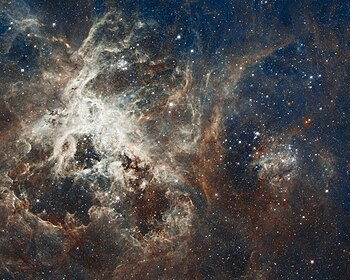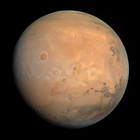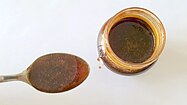Wikipedia:2008 main page redesign proposal/Combined proposal (Scottydude)
|
Tuesday 14
May |
Today's featured articleMars is the fourth planet from the Sun. It was formed approximately 4.5 billion years ago, is a terrestrial planet and is the second smallest of the Solar System's planets with a diameter of 6,779 km (4,212 mi). A Martian solar day (sol) is 24.5 hours and a Martian solar year is 1.88 Earth years (687 Earth days). Mars has two small and irregular natural satellites: Phobos and Deimos. Carbon dioxide is substantially present in Mars's polar ice caps and thin atmosphere. It has the highest mountain in the solar system, Olympus Mons, and the largest canyon, Valles Marineris. There are large annual temperature swings on the surface, between −78.5 °C (−109.3 °F) and 5.7 °C (42.3 °F) – similar to Earth's seasons. Due to its geological history, the possibility of past or present life on Mars remains of great scientific interest. Mars has been explored by uncrewed spacecraft and rovers, and is an attractive target for future human exploration missions. (This article is part of a featured topic: Solar System.)
Recently featured:
In the news...
|
AboutWikipedia is a free encyclopedia, collaboratively written over the internet by volunteers with 6,823,541 articles in English and more than 11 million in over 250 languages. Find an articleExploreVillage pump » Community portal » Site news » Mobile access » More projects »
Sister Projects
|
Did you know...
- ... that hallucinogenic honey (pictured) was used as a biological weapon more than 2000 years ago?
- ... that after failing to qualify for prestigious races as an athlete, Mounir Akbache became a rabbit?
- ... that the memorial Ivančena was created to honor members of the Silesian Scout Resistance who were executed for their part in the resistance to Nazi occupation during World War II?
- ... that Lewis W. Green was one of the two members of the first graduating class of Centre College and later became its president?
- ... that "Toy Town" was said to have "almost destroyed" the happy hardcore scene?
- ... that William F. Fiedler was the only American fighter pilot to become a flying ace in the P-39 Airacobra?
- ... that nearly a thousand elections for local executives were held in Indonesia between 2005 and 2013, with an average of around one every three days?
- ... that although Agnes Kimball was a popular recording artist of opera and musical theatre, she never appeared as a singing actress on the stage?
- ... that 287 Broadway was once called "the most succulent cast-iron street-show in all New York"?
On this day...
May 14: Feast day of Saint Matthias (Catholicism); Independence Day in Israel (2024)
- 1264 – Second Barons' War: King Henry III was defeated at the Battle of Lewes (monument pictured) and forced to sign the Mise of Lewes, making Simon de Montfort the de facto ruler of England.
- 1857 – Mindon Min was crowned as King of Burma.
- 1863 – American Civil War: Union troops captured Jackson, the capital of Mississippi.
- 1931 – Five people were killed in Ådalen, Sweden, as soldiers opened fire on an unarmed trade union demonstration.
- 1948 – David Ben-Gurion publicly read the Israeli Declaration of Independence at Independence Hall in Tel Aviv.
- Fanny Imlay (b. 1794)
- Mary Seacole (d. 1881)
- Miranda Cosgrove (b. 1993)
- Taruni Sachdev (b. 1998; d. 2012)
Today's featured picture

|
The Tarantula Nebula, also known as 30 Doradus, is a large H II region in the Large Magellanic Cloud (LMC). It is one of the largest H II regions in the Local Group, with an estimated diameter around 650 to 1860 light years. It is around 160,000 light-years from Earth and has apparent magnitude of 8. The Tarantula Nebula was first observed by Nicolas-Louis de Lacaille during an expedition to the Cape of Good Hope between 1751 and 1753. This high-resolution photograph was taken by the Hubble Space Telescope and shows the star-forming region of Tarantula Nebula with the R136 super star cluster at its center. Photograph credit: NASA, ESA, Space Telescope Science Institute
Recently featured:
|




